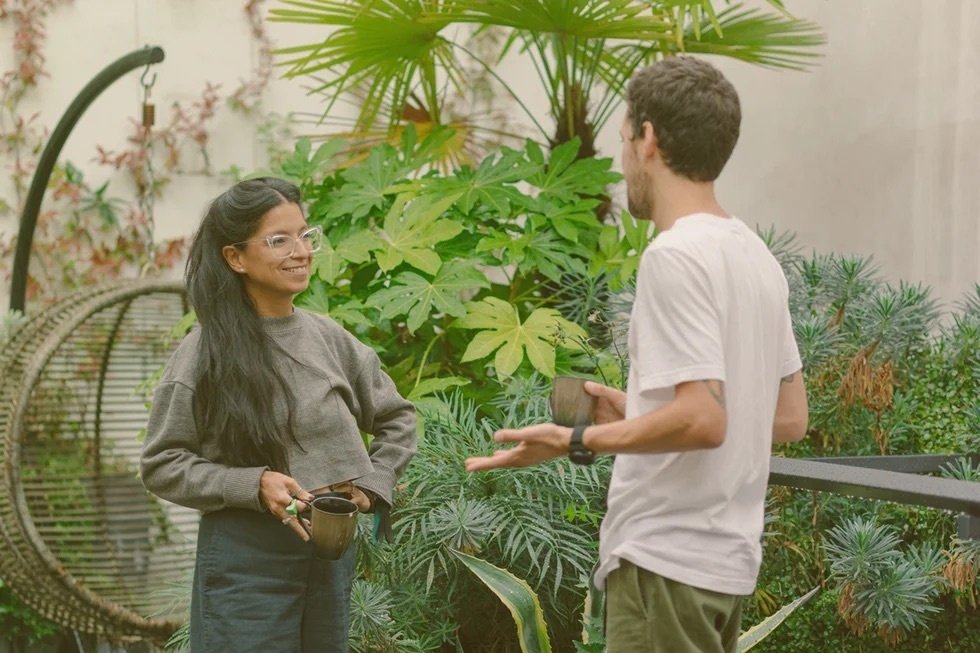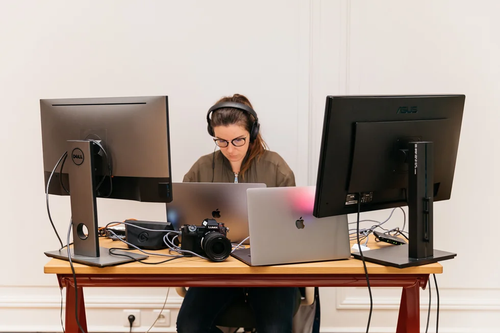The dynamic benefits of walking meetings
Oct 03, 2023
6 mins


US Editor at Welcome to the Jungle
The power of nature, combined with the act of walking, can rewire our cognitive functions, nurture creativity, and foster deeper interpersonal relationships at work. Those might sound like big claims to make, but they are backed up by science. Remember the phrase that emerged a few years ago? “Sitting is the new smoking.” While it might seem like a dramatic comparison, the underlying idea is accurate. Sitting for extended periods and having a sedentary lifestyle has been shown to lead to health issues and increase the likelihood of early death.
Walking, on the other hand, enhances overall health and reduces the chances of premature death. How much can make a difference? We need to take 150 minutes a week of moderate-intensity aerobic activity, according to the most recent physical activity guidelines from the US Department of Health and Human Services, Office of Disease Prevention and Health Promotion. Better yet, increasing even moderate activity levels by just 10 minutes a day could prevent 110,000 deaths per year among those who are over 40 years old, according to new research study published in JAMA Internal Medicine.
The contrast between our active ancestors and today’s office-bound professionals is stark. Where long hours behind desks and screens have become the norm, the need for change is pressing. But instead of lamenting our sedentary state, we can take proactive measures. If the health benefits alone aren’t convincing enough, consider the added advantages of increased focus, creativity, and team bonding.
Enter: walking meetings. This fresh approach offers dual benefits. Not only do they address the adverse health effects of our stationary work lives, but they also introduce an element of dynamism and collaboration into otherwise mundane work routines.
The cognitive refresh of walking meetings
Walking meetings offer more than just fresh air, movement, and a change of scene. “It’s a chance to clear your head,” explains Prof Julia Milner, who has 18 years of experience in coaching and training executives in leadership. Milner has been named in the World’s ‘Top 40 Business Professors under 40’ and hosts two YouTube channels on Positive Work Vibes and the CEO Diet. She explains that by “stepping away from the confines of our desks and screens, we’re given a new perspective, almost like ‘zooming out.’” This shift not only renews our focus but also serves as a gentle reminder that life is more than work, Milner explains, and “such experiences are essential for overall well-being.”
Ever notice how a simple stroll in the park can change your outlook for the day? Nature has a unique ability to recharge our minds. Spending time outside isn’t just about the view; it’s about engagement. When the sights and sounds of nature surround us, we feel more connected to our tasks, according to Wendy Cole, the founding director of iMastery, a consultancy dedicated to helping professionals invest in staff development.
Take Japanese “forest bathing,” for example, which involves being calm and breathing deeply outdoors, ideally while surrounded by trees. Science, in the form of attention restoration theory, backs up the idea that immersing ourselves in nature in this way rejuvenates our cognitive functions. In layperson’s terms? Being in nature helps us to think more clearly. “[It helps us] access the prefrontal cortex,” she says. “This is essentially what we use as knowledge workers: our capacity to problem solve, consider different points of view, prioritize, and focus. And time in nature… helps us use our executive function part of our brain.” Nature acts like a spa retreat for this part of the brain, ensuring we get the best from it.
Positive energy is contagious
This applies to the workplace, too. Drawing from the insights of Courtney Ackerman, Cole highlights the significance of nature in our cognitive and emotional well-being. She notes that nature can rejuvenate our attention, especially after intense mental exertion like prolonged studying or demanding work projects. Building on this, Cole adds, “My sense is that time in nature can help us to improve our focus and ability to concentrate, and to recover from stress. The reduction in stress has many benefits. One likely correlation with staff being less stressed is higher functioning team dynamics.”
While nature plays a pivotal role in stress restoration, Cole says that simply walking side-by-side can be transformative in cultivating deeper bonds among colleagues. She points out that, much like a car ride, it can pave the way for profound discussions and increased connectivity. The physical act of moving together aligns with the mental synchronization nature fosters, amplifying the bond between colleagues.
For Milner, when you make walking meetings a habit, “you not only benefit from the endorphins and the touch of vitamin D, but you also radiate positivity.” This positivity isn’t just an internal feeling – it spreads to others too. “There’s the concept called emotional contagion,” she explains. “Our emotions are contagious.” When one is in high spirits from a walk or simply being outside, it’s conveyed in their tone, words, and even actions, making interactions with others more fruitful. “Emotional contagion not only influences our mood but also enhances our creativity,” Milner says. “You get new ideas from each other.” This heightened bond fosters greater psychological safety in the workplace, paving the way for creative ideas to thrive.
How walking helps with focus
For Milner, being away from the screen helps her be more structured, organized, and intentional in her actions. She’s focused on making the conversation as meaningful as possible when walking and talking with someone. “I often ask myself before the meeting, ‘What do you hope to achieve from this meeting? What’s essential to you?’ This helps me stay on point and be more considerate of the other person’s time.”
“While walking,” Milner says, “I’m solely engaged in the conversation, free from other distractions.” She believes this focused approach is key to building genuine connections, adding, “Offering someone our full attention and time is the most precious gift.” She contrasts this with interactions on a laptop. “It’s hard to say if we’re ever truly present in the same way,” she says.
It isn’t just about walking; it’s about “doing something different, being in a different environment,” she says. The goal is to immerse oneself in varied stimuli and ensure everyone can benefit, even those with disabilities. Whether being in fresh air or engaging in different forms of movement, the emphasis is on change and breaking the routine.
Go for a walk wherever you are
A common assumption is that walking meetings require picturesque outdoor settings. Yet, Milner points out that you can conduct walking meetings even in an “office building in the middle of a parking lot” or places with harsh weather. A practical solution could be to conduct these meetings inside spacious buildings. Cole notes that despite the adage “there’s no such thing as bad weather, only bad clothing,” practical constraints exist. Even if outdoor conditions aren’t always ideal, holding “one walking meeting a week is better than none,” Cole says.
There are occasions when walking meetings might not be appropriate, according to Milner, especially “high-level” ones where presentation is critical and everyone is on camera. For group meetings, Milner advises evaluating the nature and purpose of each meeting. If your contribution is passive or informational, walking might be feasible. However, if active engagement and presentation are required, it might be best to stay in one place. She points out that walking meetings with up to three or four individuals can be manageable. However, for larger groups, she suggests breaking them into smaller sub-groups.
Inclusivity is vital. So, if a colleague has a disability that prevents walking, for example, Cole suggests trying alternatives such as sitting at a cafe, enjoying the sunshine, or choosing a room filled with plants that can offer a brighter ambience.
How to handle skepticism
Navigating the skepticism around walking meetings can be a challenge as some people may feel it’s impolite to walk during a meeting, fearing it conveys a lack of focus. Cole says, “I would argue that one would focus a lot better walking than sitting at a desk.” Show them scientific evidence of the benefits of walking meetings, she says. Or ask them to do it once. “You can say ‘Can we just give this a try? It’s not a permanent change. Let’s see how it benefits everyone’,” explains Cole. Milner recommends addressing any qualms upfront. Informing the other party that you’re moving between locations or simply asking for their comfort level can alleviate concerns. Friends, she mentions, might even encourage each other to engage in simultaneous walking meetings.
Forge a new path
Walking meetings are emerging as a refreshing, productive, and holistic approach to professional engagements. However, consistency is crucial when integrating new habits into one’s routine. Milner says, “If you sporadically do walking meetings and then stop, it loses its effectiveness.” She suggests doing a personal audit to truly benefit. “Take an inventory of how many steps you’re currently taking,” she says. “Then, review your upcoming meetings for the week to identify which ones could be transformed into walking meetings.” Initiating the practice with familiar colleagues can ease the transition. “I believe it’s courteous to ask for their preference,” Milner adds. She also strongly advises beginning with modest goals. “Start small and recognize the benefits as you go along. Incorporating walking meetings is simple and can easily be integrated,” she explains.
While there are practical constraints and perceptions to navigate, the overwhelming evidence points to the benefits of on-the-move discussions. Whether it’s a stroll in a park, a walk inside an office building or shopping center, or a virtual meeting while pacing in one’s backyard, the shift away from the conventional desk set-up is a step towards embracing a more mindful, effective, and connected work culture.
Photo: Welcome to the Jungle
Follow Welcome to the Jungle on Facebook, LinkedIn, and Instagram to get our latest articles every day, and don’t forget to subscribe to our newsletter!

More inspiration: Physical health

Navigating your career while managing chronic illness
Struggling to juggle work and chronic illness? Learn how to create a supportive career path and find solutions.
Dec 24, 2024

The best equipment to help you get exercise without leaving your desk
A sedentary lifestyle can lead to serious health problems. So, how can you stay fit while still at your desk?
Nov 09, 2023

Glued to your desk all day? Try these discreet exercises
Laptop-based work can mean freedom and comfort, but a sedentary lifestyle also brings a host of health risks...
Oct 18, 2023

How the world of work is getting better for veterinarians
Though typically not considered a dangerous profession, veterinary services rank among the highest industries for non-fatal injuries
Oct 04, 2023

Digital eye strain: You are not alone
With the average American spending more hours in front of the screen than sleeping, computer vision syndrome has become a folk illness.
Oct 04, 2022
The newsletter that does the job
Want to keep up with the latest articles? Twice a week you can receive stories, jobs, and tips in your inbox.

Looking for your next job?
Over 200,000 people have found a job with Welcome to the Jungle.
Explore jobs